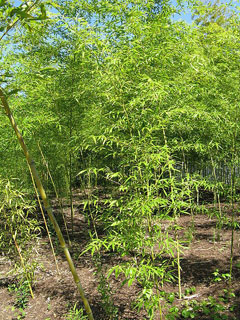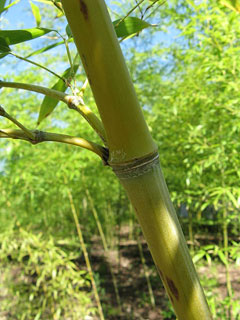 |
|
http://commons.wikimedia.org/wiki/User:KENPEI |
 |
| http://commons.wikimedia.org/wiki/User:KENPEI |
Translate this page:
Summary
Golden Bamboo (Phyllostachys aurea) is used in soups, stir-fries, or pickled and tolerates semi-arid conditions.
Common Bamboo (Bambusa vulgaris) young shoots are edible when cooked. They are harvested while tender and used in stir-fries, soups, and pickles. Once established, Common Bamboo is moderately drought-tolerant, but supplemental watering is necessary during long dry spells.
When used as a hedge, once the culms (poles) have been cut shorter, they will not re-grow taller from that cut point.
Form: Oval, Upright or erect.
Physical Characteristics

 Phyllostachys aurea is an evergreen Bamboo growing to 6 m (19ft) by 6 m (19ft) at a fast rate.
Phyllostachys aurea is an evergreen Bamboo growing to 6 m (19ft) by 6 m (19ft) at a fast rate.
See above for USDA hardiness. It is hardy to UK zone 6. It is in leaf all year. The species is hermaphrodite (has both male and female organs) and is pollinated by Wind. The plant is self-fertile.
It is noted for attracting wildlife.
Suitable for: light (sandy), medium (loamy) and heavy (clay) soils. Suitable pH: mildly acid, neutral and basic (mildly alkaline) soils. It can grow in semi-shade (light woodland). It prefers moist soil and can tolerate drought.
UK Hardiness Map
US Hardiness Map
Synonyms
P. bambusoides aurea. Bambusa aurea. Sinarundinaria aurea.
Plant Habitats
Woodland Garden Dappled Shade; Shady Edge;
Edible Uses
Edible Parts: Seed Shoots Stem
Edible Uses:
Young shoots - cooked[61, 105, 177]. They can also be eaten raw and have very little bitterness[183]. They are said to be the sweetest of the genus[25]. The canes are about 15mm in diameter[K]. In China, the new canes are 2 - 5cm in diameter[266]. The shoots are harvested in the spring when about 8cm above the ground, cutting them about 5cm below soil level. Seed - raw or cooked. The seed is only produced at intervals of several years, it can be eaten in all the ways that rice s used and can also be ground into a flour and used as a cereal[183].
References More on Edible Uses
Medicinal Uses
Plants For A Future can not take any responsibility for any adverse effects from the use of plants. Always seek advice from a professional before using a plant medicinally.
None known
References More on Medicinal Uses
The Bookshop: Edible Plant Books
Our Latest books on Perennial Plants For Food Forests and Permaculture Gardens in paperback or digital formats.

Edible Tropical Plants
Food Forest Plants for Hotter Conditions: 250+ Plants For Tropical Food Forests & Permaculture Gardens.
More

Edible Temperate Plants
Plants for Your Food Forest: 500 Plants for Temperate Food Forests & Permaculture Gardens.
More

More Books
PFAF have eight books available in paperback and digital formats. Browse the shop for more information.
Shop Now
Other Uses
Paper Plant support Wood
Agroforestry uses: used for erosion control, as a windbreak, and as a source of timber for construction and crafts. It can also be integrated into agroforestry systems as a shade provider and ground cover. The canes make excellent plant supports and are also used for making items such as umbrella handles, walking sticks, fan handles and pipe stems[25, 162, 195]. The canes are very hard but super-flexible[195]. A fibre from the stems is used for making paper[189]. The stems are harvested at any time of the year and crushed with a hammer. They are then cooked for 2 hours or more with lye and beaten in a ball mill for 4 hours. The fibre makes a yellow/gold to cream paper[189].
Special Uses
Food Forest
References More on Other Uses
Cultivation details
Landscape Uses:Container, Screen, Specimen. Requires a rich damp soil in a sheltered position[200]. Dislikes prolonged exposure to hard frosts[200]. Established plants are drought resistant[74]. A very hardy bamboo, it succeeds in most parts of Britain[25] but suffers leaf and culm damage at temperatures below about -15°c. Plants only flower at intervals of many years. When they do come into flower most of the plants energies are directed into producing seed and consequently the plant is severely weakened. They sometimes die after flowering, but if left alone they will usually recover though they will look very poorly for a few years. If fed with artificial NPK fertilizers at this time the plants are more likely to die[122]. Although called the ' Golden Bamboo', the leaves of this plant only turn golden if plants are grown in full sun[195], especially if the plants are half-starved. This species is considered by some botanists to be a part of P. bambusoides[25]. Cultivated for its edible shoots in China[25, 162], it has the sweetest taste of the genus[25]. It has been widely planted as an ornamental in the Mediterranean and seems to be naturalizing there[50]. This species is notably resistant to honey fungus[200]. The rootstock is running[25], but not aggressively so, the plant forming fairly tight clumps[195]. New shoots are produced from late May[25]. This is a good companion species to grow in a woodland because the plants have shallow root systems that do not compete with deep tree roots[195]. Special Features: Not North American native, Naturalizing, Inconspicuous flowers or blooms. Self-fertile, allowing it to produce seeds without the need for cross-pollination. Harvested for shoots in spring. The culms (stalks) are usually harvested in late summer to early autumn.
References Carbon Farming Information and Carbon Sequestration Information
Temperature Converter
Type a value in the Celsius field to convert the value to Fahrenheit:
Fahrenheit:
The PFAF Bookshop
Plants For A Future have a number of books available in paperback and digital form. Book titles include Edible Plants, Edible Perennials, Edible Trees,Edible Shrubs, Woodland Gardening, and Temperate Food Forest Plants. Our new book is Food Forest Plants For Hotter Conditions (Tropical and Sub-Tropical).
Shop Now
Plant Propagation
Seed - surface sow as soon as it is ripe in a greenhouse at about 20°c. Do not allow the compost to dry out. Germination usually takes place fairly quickly so long as the seed is of good quality, though it can take 3 - 6 months. Grow on in a lightly shaded place in the greenhouse until large enough to plant out. Seed is rarely available. Division in spring as new growth commences. Divisions from the open ground do not transplant well, so will need careful treatment and nurturing under cover in pots until at least late spring[238]. Division is best carried out in wet weather and small divisions will establish better than large clumps[238]. Another report says that you can take large divisions from established clumps and transfer them straight to their permanent positions, misting or drenching them frequently until they are established[200]. Basal cane cuttings in spring.
Other Names
If available other names are mentioned here
Native Range
TEMPERATE ASIA: Fujian Sheng, Taiwan, Zhejiang Sheng,China.
Weed Potential
Right plant wrong place. We are currently updating this section.
Please note that a plant may be invasive in one area but may not in your area so it's worth checking.
Conservation Status
IUCN Red List of Threatened Plants Status :

Growth: S = slow M = medium F = fast. Soil: L = light (sandy) M = medium H = heavy (clay). pH: A = acid N = neutral B = basic (alkaline). Shade: F = full shade S = semi-shade N = no shade. Moisture: D = dry M = Moist We = wet Wa = water.
Now available:
Food Forest Plants for Mediterranean Conditions
350+ Perennial Plants For Mediterranean and Drier Food Forests and Permaculture Gardens.
[Paperback and eBook]
This is the third in Plants For A Future's series of plant guides for food forests tailored to
specific climate zones. Following volumes on temperate and tropical ecosystems, this book focuses
on species suited to Mediterranean conditions—regions with hot, dry summers and cool, wet winters,
often facing the added challenge of climate change.
Read More
Expert comment
Author
(Carrière.)Rivière.&C.Rivière.
Botanical References
11200266
Links / References
For a list of references used on this page please go here
Readers comment
© 2010, Plants For A Future. Plants For A Future is a charitable company limited by guarantee, registered in England and Wales. Charity No. 1057719, Company No. 3204567.